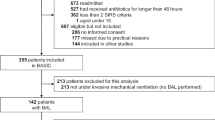Abstract
Objective
Measurement of hydrogen peroxide concentrations in breath condensate of mechanically ventilated patients with ARDS and with risk factors for developing ARDS.
Design
Open study in intensive care patients.
Setting
Intensive care units of the Clinics of the University of Goettingen, a primary care center.
Patients
10 post-operatively ventilated patients as a control group and 26 patients with acute respiratory failure, 7 of them with ARDS, 12 with polytrauma, 4 with pneumonia, 3 with cardiogenic or nephrogenic pulmonary edema.
Interventions
None.
Measurements
Breath condensate was collected by a special cold trap and was analysed for H2O2 by a chemiluminescence method. Daily measurements were performed for 4.2±2.6 days (mean±SD) as soon as possible after manifestation of respiratory failure.
Results
Patients with acute respiratory failure exhibited higher H2O2 concentrations than control patients (median 95 nmol/l, range 76–144 nmol/l), with the highest median value found in the ARDS group (552 nmol/l, range 154–893). After clinical improvement, H2O2 concentrations decreased to the range of the control group.
Conclusion
Since high concentrations of H2O2 in breath condensate were only found in patients with ARDS or with risk factors for ARDS, the results add to the existing evidence that reactive oxygen species are associated with some acute lung diseases.
Similar content being viewed by others
References
Simon RH, Ward PA (1988) Adult respiratory distress syndrome. In: Gallin JI, Goldstein IM, Snyderman R (eds) Inflammation: basic principles and clinical correlates. Raven Press. New York, pp 815–827
Junod AF (1989) Oxygen free radicals and lungs. Intensive Care Med 15:S21-S23
Demling RH (1990) Current concepts on the adult respiratory distress syndrome. Circ Shock 30:297–309
Wiener-Kronish JP, Gropper MA, Matthay MA (1990) The adult respiratory distress syndrome: definition and prognosis, pathogenesis and treatment. Br J Anaesth 65:107–129
Tate RM, Repine JE (1983) Neutrophils and the adult respiratory distress syndrome. Am Rev Respir Dis 128:552–559
Baldwin SR, Simon RH, Grumm CM, Ketai LH, Boxer LA, Devall LJ (1986) Oxidant activity in expired breath of patient with adult respiratory distress syndrome. Lancet I:11–14
Sznajder JI, Fraiman A, Hall JB, Sanders W, Schmidt G, Crawford G, Nahum A, Factor P, Wood LDH (1989) Increased hydrogen peroxidase in the expired breath of patients with acute hypoxemic respiratory failure. Chest 96:606–612
Ingelstedt S (1956) Studies of the conditioning of air in the respiratory tract. Acta Otolaryngol [Suppl] 131:1–81
Dery R (1973) The evolution of heat and moisture in the respiratory tract during anaesthesia with a non-rebreathing system. Can Anaesth Soc J 20:296–306
Sakugawa H, Kaplan IR (1987) Atmospheric H2O2 measurement: comparison of cold trap method with impinger bubbling method. Atmospheric Environ 21:1791–1798
Yoshizumi K, Aoki K, Nouchi I, Okita T, Kobayashi T, Kamakura S, Tajima M (1984) Measurements of the concentration in rainwater and of Henry's law constant of hydrogen peroxide. Atmospheric Environ 18:395–401
Cochrane CG, Spragg RG, Revak SD, Cohen AB, McGuire WW (1983) The presence of oxidation activity in bronchoalveolar lavage fluid of patients with adult respiratory distress syndrome. Am Rev Respir Dis 127:S25-S27
Cross CF, Forte T, Stocker R, Lowie S, Yamamoto Y, Ames BN, Frei B (1989) Oxidative stress and abnormal cholesterol metabolism in patients with adult respiratory distress syndrome. J Lab Clin Med 115:396–404
Weiland JE, Davis WB, Holter JF, Mohammed JR, Dorinsky PM, Gadek JK (1986) Lung neutrophils in the adult respiratory distress syndrome: clinical and pathophysiological significance. Am Rev Respir Dis 133:218–225
Thommasen H, Russel A, Boyho W (1984) Transient leukopenia associated with adult respiratory distress syndrome. Lancet I:809–812
Author information
Authors and Affiliations
Additional information
The study was supported by the Deutsche Forschungsgemeinschaft, project Ka 464, and by the Sonderforschungsbereich 330 “Organprotektion”, Teilprojekt B11
Rights and permissions
About this article
Cite this article
Kietzmann, D., Kahl, R., Müller, M. et al. Hydrogen peroxide in expired breath condensate of patients with acute respiratory failure and with ARDS. Intensive Care Med 19, 78–81 (1993). https://doi.org/10.1007/BF01708366
Received:
Accepted:
Issue Date:
DOI: https://doi.org/10.1007/BF01708366




